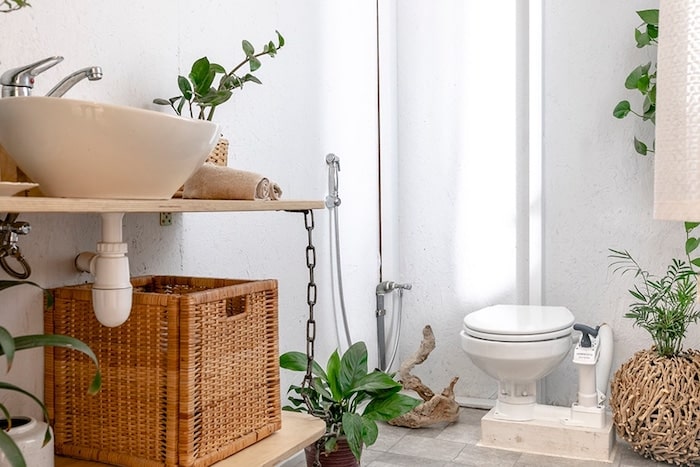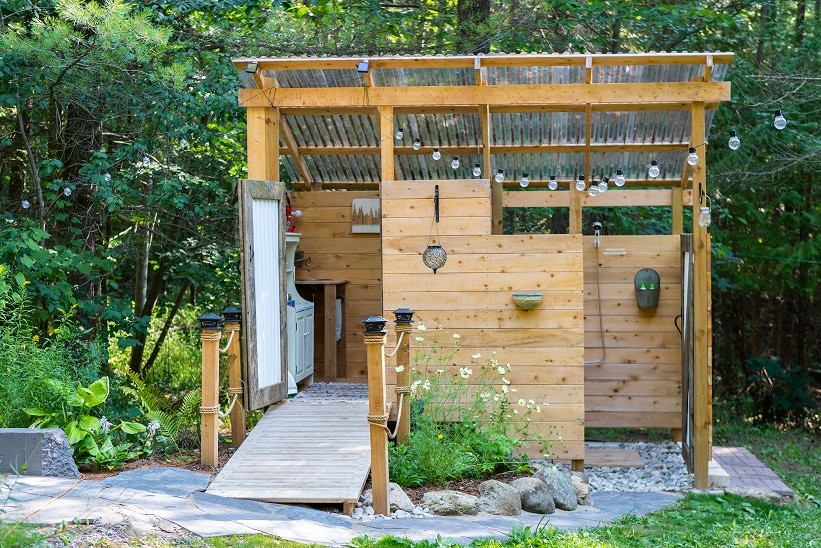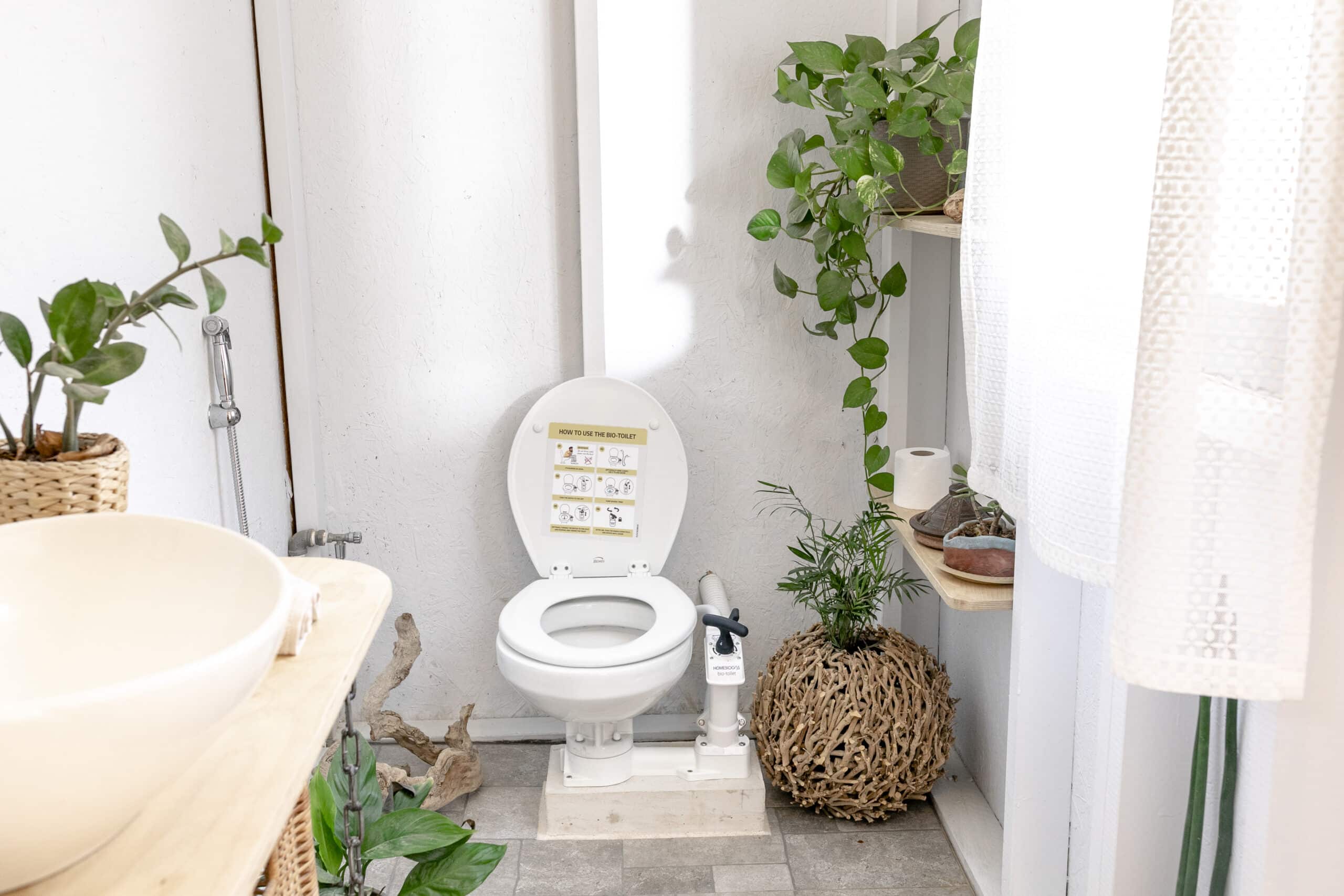
What is an outdoor composting toilet?
A composting toilet is a waste management system that gathers and composts human waste. It’s a sustainable process that enables you to turn what many consider a usable residue into a resource. The compost resulting from the process can become fertilizer for lawns and gardens, supporting plant growth and rebalancing soil. and in the case of using a toilet with a biodigester, you can produce organic liquid fertilizer that is great for immediate impact on your soil.
An outdoor composting toilet might be similar to a traditional privy or outhouse on the outside. However, we’re looking at a more sustainable, healthier, and environmentally friendly alternative that enables you to live a self-sufficient life with a minimum impact on the environment. That’s because these systems are usually waterless or use minimum amounts of clean water to function correctly, making them an eco-friendly waste management solution.
How do outdoor composting toilets work?
Most outdoor composting toilets use aerobic digestion to facilitate the decomposition of human waste inside a composting chamber or digester. Bacteria break down the organic matter and slowly digest it to obtain a dry, odorless material that can be used as fertilizer.
For this to happen, the composting chamber must reach the right balance of temperature, humidity, and oxygen amount in which aerobic bacteria that transform the waste can thrive. Ventilation is essential for the system to work correctly for an odorless, fast process.
Most composting toilets include a standard composting chamber or box which allows the air to circulate, and aerobic composting happens fast and with no odors.
The process includes three primary steps:
- Removal of the excess liquid to balance humidity levels inside the digester. (Not all composting toilets can do this, though.)
- The fermentation process to turn human waste into compost.
- Disposal of fertilizer in line with local laws.
Depending on the outdoor composting toilet you opt for, you can have a system that performs all these steps using fans and pipes to supply oxygen and transport waste, or you might have to include additional elements and sometimes perform manual tasks as part of your daily chores.
Also, a carbon additive, such as coconut coir, sawdust, or peat moss, may be needed to support the decomposition process while keeping odors away.
Outdoor composting toilets – pros & cons
Outdoor composting toilet advantages:
- It’s an eco-friendly system that saves water and energy.
- You get to turn human waste into something useful.
- Overall, these systems are easy to use and maintain.
- While they might require upfront expenses, they are cost-effective in the long run.
Outdoor composting toilet disadvantages:
- They’re not as practical as flushing toilets.
- Some models require regular emptying.
- Energy is often necessary to ensure the system works properly.
- Some visitors may not feel comfortable using them.
A word on average household water usage statistics
One of the most significant benefits of outdoor composting toilets is reduced water consumption. The average American family uses more than 300 gallons (1,363 liters) of water per day at home, and most of it happens indoors, with flushing being often the primary water-consuming activity.
Composting toilets use a fraction of the water traditional toilets require, like the HomeBiogas Bio-toilet which uses only 1.2 liters a flush. Some models are even waterless, making this waste management system very sustainable and eco-friendly.
Flushing doesn’t solve a problem but creates one. Blackwaters (water mixed with human waste) are foul and contain dangerous bacteria that can spread disease if not properly stored and treated. To recycle these waters, we consume significant resources, and the process impacts the environment.
Composting toilets can reduce our carbon footprint and enable us to live a sustainable life by reducing the amounts of water turned into blackwaters.
The best 2022 outdoor composting toilets
1. The HomeBiogas Bio-Toilet Kit
The HomeBiogas Bio-Toilet Kit is an outdoor composting toilet with a twist. It’s an innovative alternative to compost toilets on the market, as it uses anaerobic digestion to produce fertilizer and biogas for cooking.
The installation doesn’t require significant ground work, so the kit is easy to install—it also comes with an installation manual (plus YouTube videos for extra guidance) for a hassle-free process. Moreover, the provider also has an instructions sticker, so all your guests are comfortable using the system.
The HomeBiogas Bio-Toilet Kit is 100% environmentally friendly and ideal for off-grid properties. It comes with everything you need to store and compost waste and all the elements necessary to use the biogas for cooking.

HomeBiogas Bio-toilet
Designed for the next generation of green innovation.
2. SereneLife Outdoor Portable Toilet
SereneLife Outdoor Portable Toilet is a portable, outdoor composting toilet suitable for camping, mobile homes, and off-grid small properties. It doesn’t take up much space, is corrosion-resistant, and is made of odor-resistant materials that don’t retain smells. Moreover, it comes with a 5.3-gallon toilet tank, larger than many portable toilets on the market.
The downside is that you need to empty it periodically, so you need a separated composting box to treat the waste and turn it into fertilizer.
3. Nature’s Head Self Contained Composting Toilet
Nature’s Head Self Contained Composting Toilet comes with a 5-foot flex hose connected to a pipe that enables ventilation. The vent fan is built into the toilet and requires 12 volts of DC power to function — it also has an adaptor for 110 volts of AC.
The model comes with a urine separator, but this must be emptied almost daily. The remaining waste starts composting quickly, so the solids take up little space, and the tank requires emptying after about 80 usages.
4. Separett Villa
Separett Villa is waterless and urine-diverting and can operate with standard on-grid power and or battery/solar power. It has a speed fan for venting and a waste container with a lid. The system catches the urine in a drain plumbed to a holding tank while solid waste and paper end in a compostable liner bag.
You need to change the bag after an average of 3 weeks (for family use) and deposit it into a dedicated composter. Alternatively, you can incinerate it.
Installing and maintaining an outdoor composting toilet
Depending on the complexity of the system you opt for, installation and maintenance requirements might vary. Many manufacturers provide in-depth instructions for making the process straightforward, but DIY skills and tools are required.
Many composting toilets need regular emptying and cleaning — the more straightforward and cheaper the system, the more you’ll have to work to keep it functional.
Additionally, for most of the composting toilets on the market, you’ll need an environmentally-friendly compost box where the composting process can occur if you want to turn human waste into organic fertilizer.
What the future holds for composting human waste
Producing homemade compost from human waste isn’t easy, as good compost requires specific environmental conditions. You need to ensure the composting box provides adequate moisture levels so that microorganisms thrive and do their job correctly.
It’s a natural process, but replicating it in artificial environments on a large scale comes with challenges, and it’s not always easy to create the right conditions for the proper decomposition of organic waste.
However, the benefits of using composting to simplify waste management and reduce its environmental impact can’t be ignored. So, while the system can’t be used in large communities, the popularity of composting toilets for domestic usage is likely to increase as more people will turn to these systems to be self-sufficient and reduce their carbon footprint.

Can they be used in commercial buildings?
Theoretically, composting toilets can serve commercial buildings. Practically, we’re not there yet. We might see experimental projects for composting toilets in office buildings, but things can go wrong, so more pilot projects might be necessary to identify possible issues and fix them.
Conclusion
Getting started with a composting toilet might be a little challenging at first, but if you follow the instructions and pick the right system for your property’s needs, you’ll see excellent results fast.
A modern composting toilet that requires minimum to no maintenance can come with significant upfront costs, so you want to do your due diligence and educate yourself about the pros and cons before buying.







